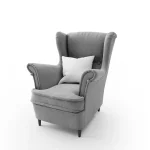In today’s world, more and more people are becoming aware of the environmental impact of their lifestyle choices, including the furniture they bring into their homes. Sustainable living isn’t just a trend; it’s a conscious way of life that helps reduce our ecological footprint. One of the easiest ways to start living more sustainably is by choosing eco-friendly furniture. But what does that mean, and how can you make sure the pieces you select are truly good for the planet?
In this article, we’ll explore what makes furniture eco-friendly, share tips on how to choose sustainable pieces, and introduce you to some options that are both stylish and kind to the environment.
Understanding Eco-Friendly Furniture
Eco-friendly furniture is designed and produced with the environment in mind. This means it’s made from sustainable materials, manufactured ethically, and built to last, reducing the need for frequent replacements. Choosing eco-friendly furniture is more than just a good deed—it’s a way to ensure that your home is both beautiful and responsible.
A Sustainable Interior Designer explains, “Choosing eco-friendly furniture is a conscious decision that benefits both your home and the planet. Look for pieces made from sustainable materials and produced ethically.” This means paying attention to the entire lifecycle of the furniture—from the source of the materials to the way it’s disposed of at the end of its life.
Sustainable Materials: What to Look For
One of the first steps in selecting eco-friendly furniture is to understand the materials used in its construction. Sustainable materials are those that are renewable, recyclable, or reclaimed, and have a minimal impact on the environment.
Environmental Scientists recommend prioritizing furniture made from recycled or reclaimed materials. “Prioritize furniture made from recycled or reclaimed materials to reduce the demand for virgin resources and minimize waste,” they advise. Here are a few sustainable materials to consider:
- Reclaimed Wood: Reclaimed wood comes from old buildings, barns, or other structures that are no longer in use. Instead of cutting down new trees, reclaimed wood gives new life to existing materials. It often has a unique, weathered look that adds character to furniture.
- Bamboo: Bamboo is a fast-growing, renewable resource that is stronger than many types of wood. It’s also naturally resistant to pests, which reduces the need for chemical treatments.
- Recycled Metal and Plastic: Furniture made from recycled metal or plastic helps keep waste out of landfills and reduces the need for new raw materials. These pieces can be just as durable and stylish as those made from new materials.
- Organic Textiles: Upholstery and cushions made from organic cotton, wool, or linen are free from harmful chemicals and pesticides. Look for certifications like the Global Organic Textile Standard (GOTS) to ensure that the textiles meet strict environmental and social criteria.
In my own home, I’ve found that furniture made from reclaimed wood adds a rustic charm that’s hard to find in new materials. We recently added a dining table made from reclaimed oak, and not only does it look stunning, but it also feels good knowing that no new trees were cut down to make it.
Certifications: What to Look For
When shopping for eco-friendly furniture, it’s important to look for certifications that verify the sustainability of the materials and the ethical practices of the manufacturer. Furniture Manufacturers emphasize the importance of transparency: “Transparency in the supply chain is crucial for ensuring the sustainability of furniture. Look for certifications like FSC (Forest Stewardship Council) to guarantee responsible sourcing.”
Here are some key certifications to keep an eye out for:
- Forest Stewardship Council (FSC): The FSC certification ensures that wood products come from responsibly managed forests that provide environmental, social, and economic benefits.
- Global Organic Textile Standard (GOTS): GOTS certification ensures that textiles meet high standards for organic content, as well as environmental and social criteria during production.
- Greenguard: This certification indicates that the product has low chemical emissions, contributing to better indoor air quality.
- Cradle to Cradle: This certification assesses the environmental and social performance of products, including their safety to humans and the environment, the use of renewable energy, water stewardship, and social fairness.
Incorporating these certifications into your purchasing decisions can help ensure that your furniture choices are genuinely sustainable.
The Role of Longevity in Sustainability
One of the most important aspects of sustainable furniture is its longevity. High-quality furniture that is built to last reduces the need for frequent replacements, which in turn reduces waste.
An Eco-Conscious Lifestyle Influencer highlights this point: “Consider the entire lifecycle of a furniture piece, from production to disposal, when making sustainable choices.” This means investing in pieces that are not only durable but also timeless in design.
For example, when we were furnishing our living room, we opted for a high-quality sofa with a classic design. Even though it was a bit more expensive upfront, we knew it would last for many years, and we wouldn’t need to replace it every few years due to wear and tear or changing trends.
Vintage and Secondhand Furniture: A Sustainable Choice
Another excellent way to embrace eco-friendly furniture is by opting for vintage or secondhand pieces. Not only does this reduce the demand for new materials, but it also gives new life to furniture that might otherwise end up in a landfill.
An Interior Design Blogger suggests, “Mixing vintage and modern pieces can add character to your home while reducing your environmental impact.” Vintage furniture often has a unique charm that can’t be replicated by new items, and incorporating these pieces into your home can create a one-of-a-kind look.
I’ve always loved visiting thrift stores and antique shops, not just for the thrill of the hunt but also for the chance to find something truly special. Our home is filled with a mix of vintage finds and new, sustainable pieces, which creates a warm, eclectic vibe that reflects our personal style while keeping our environmental impact low.
Incorporating Plants for a Greener Home
In addition to choosing eco-friendly furniture, incorporating plants into your living space is another way to create a sustainable home. Plants improve air quality, add a touch of nature to your decor, and can even enhance your mood.
A Home Decor Expert encourages, “Incorporate plants into your living space to enhance air quality and create a natural atmosphere, complementing your eco-friendly furniture choices.” Plants like snake plants, pothos, and peace lilies are not only easy to care for but also effective at filtering indoor air.
We’ve filled our home with a variety of houseplants, from small succulents on the windowsills to large fiddle leaf figs in the living room. Not only do they make our space feel more alive, but they also serve as a reminder of the importance of caring for the environment.
Sustainable Furniture Brands to Consider
Many furniture brands are now prioritizing sustainability in their production processes, offering consumers more eco-friendly options than ever before. Here are a few brands that are leading the way in sustainable furniture:
- West Elm: Known for their stylish and modern designs, West Elm is committed to sustainability. Many of their products are Fair Trade Certified and made from FSC-certified wood.
- IKEA: IKEA has made significant strides in sustainability, offering a range of products made from renewable materials. They also focus on energy efficiency in their manufacturing processes.
- Vermont Wood Studios: This company specializes in furniture made from sustainably sourced wood. They’re committed to preserving forests and offer a range of beautifully crafted pieces.
- Medley: Medley is dedicated to producing eco-friendly furniture using non-toxic materials and sustainable wood. Their products are handmade in the USA, and they prioritize both comfort and sustainability.
- Thuma: Thuma offers minimalist, modern furniture made from eco-friendly materials. Their bed frames, for instance, are crafted from repurposed wood and are designed to last a lifetime.
When we were furnishing our bedroom, we chose a bed frame from Thuma. Not only is it made from repurposed wood, but it’s also incredibly sturdy and stylish. It’s a piece we know will last for many years, which makes it a worthy investment in our sustainable living journey.
Conclusion: Making Eco-Friendly Choices for a Greener Future
Living sustainably is about making choices that benefit both your home and the planet. By choosing eco-friendly furniture, you’re not only creating a healthier living environment for yourself and your family but also contributing to the preservation of natural resources and the reduction of waste.
Remember to look for furniture made from sustainable materials, prioritize certifications like FSC and GOTS, and consider the entire lifecycle of each piece. Don’t be afraid to mix vintage and modern styles or incorporate plants into your decor for a greener home.
As you embark on your journey towards sustainable living, every choice you make has the power to make a difference. Whether it’s a reclaimed wood dining table, a sofa made from organic textiles, or a vintage armchair found at a thrift store, each piece contributes to a healthier planet and a more beautiful, responsible home.
By focusing on sustainability in your furniture choices, you’re helping to build a better future—one beautiful, eco-friendly piece at a time.









